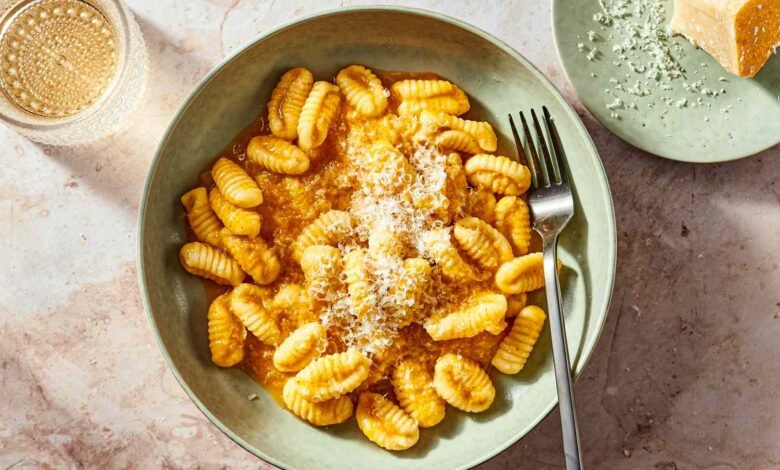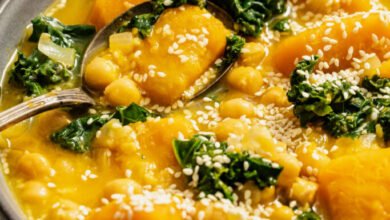This Is the Easiest Hand-Formed Pasta to Make at Home, According to a Pasta Expert


Why It Works
- Double-milled semolina flour readily absorbs water to form a pliable, easy-to-knead pasta dough.
- Briefly resting the prepared dough before shaping gives the gluten time to relax to guarantee easier pasta making.
When people think about making fresh pasta at home, they often think about flour flying around the kitchen, sticky globs of egg dough pasted onto countertops and glued onto fingers, and hours of cranking a pasta machine, slowly wrestling dough into paper-thin submission. But there’s a whole other kind of pasta-making that doesn’t involve any rolling or even any eggs. Welcome to the world of Southern Italian pasta, and one of my personal favorites: cavatelli.
Serious Eats / Qi Ai
Unlike egg pasta, which is often delicate and satiny, cavatelli—which translates to “little hollows”—are rustic, chewy, and ridiculously satisfying. Making the hollow nugget-like noodles is remarkably enjoyable. You need little more than your own two hands. Unlike shapes like fettuccine, pappardelle, and farfalle, which are made by rolling dough into thin sheets and cutting out shapes, cavatelli are formed by hand from small chunks of a pliable water-based dough. Once the dough is mixed and kneaded, it’s rolled into ropes by hand, cut into small segments, and finally pressed and rolled across the counter or a grooved hand-held pasta board to make short, thick, chewy noodles.
Serious Eats / Qi Ai
I learned to make fresh cavatelli, and all types of southern Italian pasta, when I lived in the tiny town of Conversano in Puglia. There I worked full-time in a Michelin-starred restaurant, learning and perfecting the craft of making fresh pasta from my coworkers and fellow chefs. Since my time as a culinary student and cook in Italy, my love for fresh pasta has only grown, and I now have my own pasta business, selling packaged portions of many varieties of fresh noodles at farmers markets in Martha’s Vineyard, where I live. As a pasta lover who lives and breathes it, I’ve learned a lot about making homemade cavatelli. Here’s some insight into making impressive fresh cavatelli at home.
The Right Flour for Cavatelli
As with the majority of southern Italian pastas, cavatelli dough is made from semolina flour and water, sometimes with a very small addition of olive oil. With so few ingredients, the quality and type of flour you use is vital in guaranteeing flavorful pasta. You want to look for double-milled (also called “rimacinata”) semolina flour. Semolina rimacinata is finely-ground hard durum wheat that has a high protein content, light yellow color, and a soft texture that easily absorbs water. It is ideal for kneading into pasta dough and creating supple, structured noodles.
Serious Eats / Qi Ai
The double-milled flour is key because you want the grain very finely ground to ensure dough that’s silky, not grainy. You can purchase semolina rimacinata such as the Caputo brand at specialty markets and online. I always look for semolina from Puglia, but that’s a personal preference. Don’t attempt to substitute all-purpose flour for the double-milled semolina flour in the recipe. The resulting dough will be tough with a pasty, glue-like texture.
The Different Styles of Cavatelli
Cavatelli originate from the Molise and Puglia regions of Italy, but the type of pasta has deep roots throughout Southern Italy, with regional nuances. The women I learned from in Puglia showed me how to shape smooth—”lisci”—cavatelli. Each nugget of dough was formed on their wooden counters with just their thumbs, pressing and dragging the dough until it curled over itself, forming the shell-like “little hollows.” The other style of cavatelli are ridged, or “rigati,” and are shaped using specialty pasta boards or hand-cranked pasta makers.
Serious Eats / Qi Ai
The Tools You’ll Need for Shaping Cavatelli
Smooth cavatelli are the easiest to shape and require no specialty equipment. You can simply use a butter knife or even just your thumb to scrape the dough across a flat surface to give it its hollow curled shape, and I’ve included those directions in my recipe below.
However, I prefer to make my cavatelli with ridges because I love how pasta sauce clings to the nooks. There are many different pasta tools that can be used for shaping cavatelli with ridges, but I’ve found a simple gnocchi board works the best. Hand-held gnocchi boards are fairly affordable and are available at many Italian grocers or online. Other specialty pasta boards, such as a garganelli or malloreddus board, will also work. Or, if you’re interested in artistic experimentation, look for artisanal cavarolo boards made from different types of wood with many different etched designs. As you press and roll the dough against the board, the design will imprint the pasta.
Serious Eats / Qi Ai
Another option for shaping cavatelli is a crank-operated cavatelli machine. With this small pasta maker you place a hand-rolled rope of dough between the two rollers and crank the handle while the machine cuts and shapes the noodles. It’s a very fun tool to use, and if you foresee making cavatelli on a frequent basis at home, I encourage you to consider buying one.
What Sauce Should You Serve With Cavatelli?
Now let’s talk about what kind of sauce goes with your hand-formed cavatelli that you so lovingly took the time to make. Whether ridged or smooth, cavatelli are fantastic sauce-holders. The indent in the inner cavity, whether shaped by your thumb or rolled into tight overlapping folds, catches and stores sauce very well. If you shape them “rigati” style by rolling the dough on a textured board, you’ll get even more sauce in each bite because it will cling inside the ridges.
Serious Eats / Qi Ai
A general rule when pairing pasta with sauce is that you have to pay attention to how the melange will travel from bowl to mouth. For instance, long noodles like pappardelle twirl up on your fork, traveling as a little nest. For that, you’d want a thick sauce that clings well and has components (think a slow-cooked ragu with shredded meat) that get caught up in the twirl and make it to your mouth alongside the pasta. But for short, rustic, dumpling-like pasta shapes like cavatelli, we might reach for a spoon instead of a fork. We want a looser sauce that can pool in the spoon and tuck into the little hollows of each noodle.
A fresh tomato or slow-cooked tomato sauce or even a ragu are great options, and I’ve included them below. You could also fold tender bites of cooked seasonal vegetables, such as green beans, or shavings of salty cheese like ricotta salata into the final dish. Ultimately, you want a sauce that mirrors the pure simplicity of the handmade cavatelli. Use good ingredients and it’s hard to go wrong.
Source link



